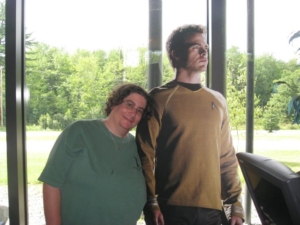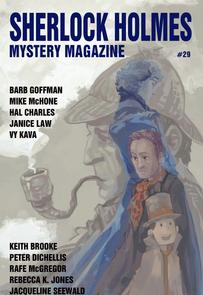Recognizing a Character’s Name in a Mystery Story
by Paula Gail Benson

Barb Goffman, writer and editor extraordinaire
Barb Goffman, whose stories have been finalists for exactly forty national crime awards, will be celebrating two nominations at San Diego’s Bouchercon. Her story “Beauty and the Beyotch,” already the winner of the Agatha Award at Malice Domestic, is among those nominated for the Anthony and Macavity.
Originally written for a themed anthology about theatre, Barb liked the final version of the story so well that she decided to submit it to major publications where it might be seen by a larger readership. Published in Issue 29 of Sherlock Holmes Mystery Magazine, Barb describes the story as “a tale about three high school girls told from two perspectives about . . . the struggle to make their deepest desires come true. What happens when those dreams collide?”
The first time I read the story, I immediately recognized one of the character’s names: Elaine Naiman, who lives in Canada and is a friend I’ve met at Malice Domestic. When I approached Elaine about an interview, she mentioned that Barb had included another name in the story, that of Joni Jackson Langevoort.
Joni explained: “Both Elaine and I learned of this opportunity for a character name in one of Barb’s stories at the Malice Domestic live charity auction; Barb asked me for a donation to my favorite local animal charity (she knew my four rescue cats and one rescue pup!), and she would use my name in a story. I did that happily, to the rescue agency where I found my beloved pup Arthur. I said she was welcome to use my full name, but because so many in the mystery community know it, she might want to use my maiden name of Jackson. I didn’t ask for any input, I felt whatever Barb wrote would be fabulous! She is an amazing short story writer, truly. And I loved the story, was so excited when it won the Agatha and have voted for it for the Macavity and Anthony awards!”
Elaine also was delighted with the outcome. She said: “Barb had a ‘Name a Character’ in an auction at Malice. I bid, but didn’t win. When I spoke to her, she told me if I made a donation to an animal charity, she’d put my name in a story. I didn’t say not to use my last name, so she used both. I didn’t have any input about the character, but I loved the story and was glad to be the ‘Beyotch.’ Usually, I’m a good person when I’m in a book.”

Joni Jackson Langevoort
I had the opportunity to ask Barb some additional questions about her story. Here are her answers:
- Did the story idea come first or did knowing the names of the characters help inspire it?
The story idea came first. When I name a character after someone who wins naming rights at an auction (or, in this case, when two people I’m friends with bid for naming rights at an auction but lost, and I offered to name characters after them if they’d make a charitable donation), I try to use the name for an important character in the story. If the character is going to be a bad guy or a victim, I make sure to ask first if the person would mind that. Some people shudder at the idea. Others relish it.
That said, sometimes the real life person influences the character. In this case, Joni the character and Joni the person both have blond hair. I could have sworn I remembered Joni the person once having a cute pixie cut, so I gave Joni the character that hairdo. The real Joni subsequently told me I’d never seen her with that haircut. It’s a good thing I write fiction.

Elaine Naiman with a figure of Chris Pine at Rock of Ages Quarry where a Star Trek movie was shot. Elaine has photos with everyone!
- How difficult was it to balance multiple points of view in the story?
“Beauty and the Beyotch” is told from only two points of view: Joni, a shy introvert, and Meryl, her new and more outgoing friend who is best friends with Elaine. Elaine views Joni as a strong rival for the starring role in the school play, which Elaine thinks is her due.
At first I’d thought about writing the story from the points of view of all three main characters (switching POV when scenes change), but I realized it wouldn’t work for the story I wanted to tell. When writing a crime story, you want to keep some things secret from the reader for part of the story—motives or thoughts or actions. Sometimes you can achieve that by having something happen between scenes or by having a character think something in a scene in which she’s not the POV character so the reader doesn’t see those thoughts. In the end, with this story, I thought it best to keep Elaine more removed from the reader. What we know of her comes only from what we see her do and say and what other characters think about her. We don’t see her thoughts.
Getting back to balance, it was a little difficult. Although I went back and forth, scene by scene, for most of the story (the story opens with a Joni scene; it’s followed with a Meryl scene, then a Joni scene, etc.), when I neared the end, storytelling needs dictated that the last three scenes be from Meryl’s perspective. The part of me that likes consistency remains bothered I didn’t have a Joni scene between Meryl’s final two, but I’m probably the only person who noticed or cared. Thankfully, I don’t think the story feels too weighted toward Meryl. If it did, that would have been a problem.

Sherlock Holmes Mystery Magazine, Issue 29
- In my previous interview with you for The Stiletto Gang, you mentioned that a key scene from the story is based on a real-life experience. Could you tell us more about that?
When I was in high school, a group of girls—whom I thought were my friends—snubbed me publicly, telling me that I couldn’t sit with them at lunch anymore. It was mean and humiliating. I like to build my stories from emotions that readers can tap into. That helps make the characters—their thoughts and actions—more real and relatable. So when I decided to write a story involving high school girls, this is the memory that popped into my head, and that’s why there’s a scene in “Beauty and the Beyotch” based on that incident. When I was plotting the story, I thought about why that incident could have come about—not why the real-life girls did what they did but why my characters might act as those girls did that day and how I could build a crime story (and a coming-of-age story) around that memory. And I did.
- Are you pleased with the reception the story has received?
Wow, yes. How could I not be? Three major award nominations for this story with one win (so far at least—fingers crossed!). I’ve heard from a bunch of readers who said they really enjoyed the story. One reader even named it his story of the week. That’s everything. I write to be read, and I write to entertain and make an impact. With “Beauty and the Beyotch,” I’ve achieved all three things. And I’ve been given the chance to reach even more readers with interviews like this, so thank you, Paula, for inviting me to do this.
Barb, Elaine, and Joni, many thanks to you all for recounting your experiences with “Beauty and the Beyotch.” For readers, if you haven’t had a chance yet, here’s a link for the story. I know you will truly enjoy it!
